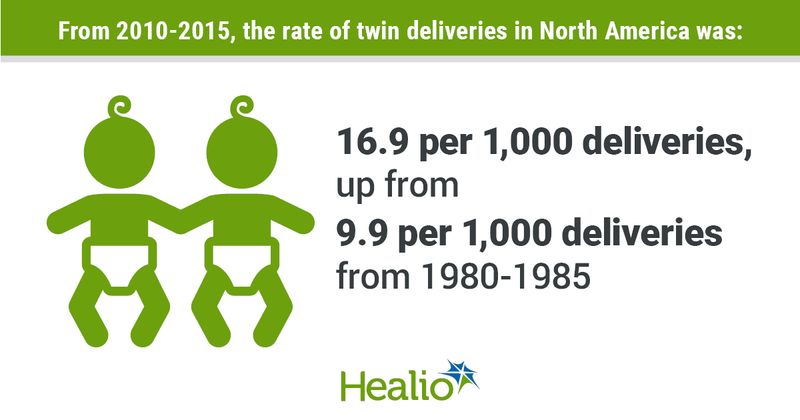Rate of twin births up 71% in North America in recent years
The rate of twin births has increased significantly since the 1980s, according to research published in Human Reproduction.
“The relative and absolute numbers of twins in the world are higher than they have ever been since the mid-20th century and this is likely to be an all-time high,” Christiaan Monden, PhD, professorial fellow and professor of sociology and demography at the University of Oxford, said in a press release. “This is important as twin deliveries are associated with higher death rates among babies and children and more complications for mothers and children during pregnancy, and during and after delivery.”

The researchers collected data on rates of twin births in 165 countries from 2010 through 2015, and in 112 countries from 1980 through 1985.
Monden and colleagues found that of the 112 countries with data available for both periods, 74% experienced a greater than 10% increase in twin births.
They found that Africa had the highest rate of twin births, but no significant increase in twin deliveries between the two periods. According to the researchers, all regions but Africa and South America experienced substantial increases in rates of twin deliveries, from an increase of 32% in Asia to an increase of 71% in North America.
They determined that, worldwide, the rate of twin births rose from 9.1 per 1,000 deliveries in 1980 through 1985 to 12 per 1,000 deliveries in 2010 through 2015.
Monden and colleagues said that the rate of twin deliveries from 2010 to 2015 suggests that, worldwide, one in every 42 children born is a twin.
In North America, the rate of twin births increased from 9.9 per 1,000 deliveries to 16.9 per 1,000 deliveries during the same period. According to the researchers, the rate of twin deliveries from 2010 to 2015 suggests that 3.4% of all children born in North America during that time were twins.
The absolute number of twin births, they said, increased more than 80% in Africa and North America.
“In Africa, this increase is almost entirely caused by population growth,” Monden and colleagues wrote.
The researchers said medically assisted reproduction (MAR) is partially the cause of increased rates of twin birth, and the increase in twin births due to MAR in the 1990s caused concern due to public health issues, including preterm birth, lower birth weight, and infant and maternal death.
These concerns prompted many developing countries to change regulations and clinical practice on MAR to reduce the number of embryos transferred and shifted focus towards successful live births of singletons.
“It therefore is possible that, in these countries, the twinning rates observed for the 2010 to 2015 period are at an all-time high and the rates might start to decrease in the coming decade,” Monden and colleagues wrote.
References:
Newswise. Twin Peaks: more twinning in humans than ever before. https://eurekalert.org/pub_releases/2021-03/esoh-tpm031021.php. Accessed March 12, 2021.
Monden C, et al. Hum Reprod. 2021;doi:10.1093/humrep/deab029.

